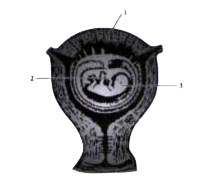Gestation period is:
Time period between two successive phases in menstrual cycle
Time period required for Trophoblast formation.
Time period between implantation and parturition.
None of these
The correct Answer is:C
Step-by-Step Solution:
1. Understanding the Question: The question asks for the definition of the gestation period. We need to identify which of the provided options correctly defines this term.
2. Analyzing the Options:
- Option A: "The time period between the two successive phases in the menstrual cycle." This option does not relate to gestation, as it refers to the menstrual cycle rather than pregnancy.
- Option B: "The time period required for trophoblast formation." This option is specific to early embryonic development but does not define the entire gestation period.
- Option C: "The time period between implantation and parturition." This option correctly describes the gestation period, as it refers to the duration from when the embryo implants in the uterus until the birth of the young.
- Option D: "None of these." This option can be eliminated since we have identified a correct option.
3. Identifying the Correct Answer: Based on the analysis, Option C is the correct answer. The gestation period is indeed the time from implantation of the embryo in the uterine wall to parturition (birth).
4. Additional Information: In humans, the gestation period typically lasts about 280 days, or approximately 40 weeks.
Final Answer: The gestation period is the time period between implantation and parturition (Option C).
---
- Option A: "The time period between the two successive phases in the menstrual cycle." This option does not relate to gestation, as it refers to the menstrual cycle rather than pregnancy.
- Option B: "The time period required for trophoblast formation." This option is specific to early embryonic development but does not define the entire gestation period.
- Option C: "The time period between implantation and parturition." This option correctly describes the gestation period, as it refers to the duration from when the embryo implants in the uterus until the birth of the young.
- Option D: "None of these." This option can be eliminated since we have identified a correct option.
Topper's Solved these Questions
- BOOK - EDUCART PUBLICATIONCHAPTER - SAMPLE PAPER 4 (SOLVED)EXERCISE - SECTION-B24videos
SAMPLE PAPER 4 (SOLVED)
- BOOK - EDUCART PUBLICATIONCHAPTER - SAMPLE PAPER 4 (SOLVED)EXERCISE - SECTION -C12videos
SAMPLE PAPER 4 (SOLVED)
- BOOK - EDUCART PUBLICATIONCHAPTER - SAMPLE PAPER 3EXERCISE - SECTION - C12videos
SAMPLE PAPER 3
- BOOK - EDUCART PUBLICATIONCHAPTER - SAMPLE PAPER 5EXERCISE - SECTION- C2videos
SAMPLE PAPER 5
Similar Questions
Knowledge Check
- Question 1 - Select One
Gestation period in man
A6 monthB7 monthC8 monthD9 month - Question 2 - Select One
Gestation period in human beings is:
A112-120 daysB145-155 daysC600-640 daysD270-290 days - Question 3 - Select One
Gestation period in human is
A10 weeksB28 weeksC32 weeksD38 weeks
Study the given diagram and answer the question given below:

Gestation period in human is:View SolutionAssertion:From evolutionary point of view,human gestation period is believed to be shortening.
Reason:From evolutionary point of view,human gestation period is believed to be shortening.
Reason:One major evolutionary trend in humans has been larger head undergoing relatively faster growth rate in the foetal stage.View SolutionAssertion (A) : From evolutionary point of view, human gestation period is believed to be shortening.
Reason (R ) : One major evolutionary trend in humans has been the larger head undergoing relatively faster growth rate in the foetal stage.View SolutionStudy the following:
A. Testosterone influences the male secondary sexual characters
B. Gestation period in rabbit is approximately 276 days
C. Bulbo-uretheral glands secrete a vaginal lubricant
D. Placenta secretes estrogen
The correct answer is:View SolutionAssertion : From evolutionary point of view, human gestation period is believed to be shortening.
Reason : One major evolutionary trend in humans has been the larger head undergoing relatively faster growth rate in the foetal stage.View Solution

